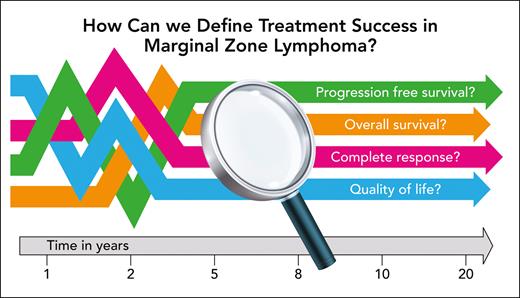In this issue of Blood, Bommier et al have tested novel end points as surrogate markers for progression-free survival (PFS) in extranodal marginal zone lymphoma (MZL) treated with systemic therapy.1 Why is this important? Indolent non-Hodgkin lymphomas, such as follicular lymphoma (FL) and MZL, have a long natural history and favorable survival. As new and more effective therapies are developed to improve outcomes even further, investigators are faced with measuring and defining treatment success using surrogate end points (SEPs) to detect the benefit of a drug (see figure).
Multiple approaches to defining success in MZL. Professional illustration by Patrick Lane, ScEYEnce Studios.
Multiple approaches to defining success in MZL. Professional illustration by Patrick Lane, ScEYEnce Studios.
Defining treatment success as an improvement in overall survival (OS) would be particularly challenging in diseases like MZL, where low numbers of events and high survival rates would necessitate exceedingly long follow-up duration to identify any degree of benefit. Thus, although considered the gold standard, this strategy in clinical trial design is both impractical and costly. An SEP is an approach used in clinical trials as an alternative for measuring true clinical benefit.2 Between 2009 and 2014, approximately two-thirds of oncology drugs approved by the US Food and Drug Administration were approved on the basis of surrogate outcomes.3 The use of SEPs in trials shortens their duration and could be a mechanism for accelerated approval, leading to faster practical application of novel anticancer therapeutics. However, rigorous methods must be undertaken to assess the predictive value of an SEP. The Follicular Lymphoma Analysis of Surrogacy Hypotheses group set a precedent in validating complete response (CR) at 30 months as a surrogate marker for PFS in FL through a meta-analysis of individual patient data from 13 randomized multicenter trials of induction and maintenance regimens in first-line FL therapy.4 Similar work has not been undertaken in MZL until now.
Two recent studies demonstrated that progression of disease within 24 months (POD24) was associated with OS in all types of MZL.5,6 Bommier and colleagues hypothesized that time-to-event end points of CR at 24 months (CR24) and 24-month time to CR (TTCR24) could be explored as surrogate markers for PFS. They analyzed the International Extranodal Lymphoma Study Group (IELSG19) study (NCT 00210353), a randomized multicenter phase 3 trial in patients with extranodal MZL (EMZL) comparing rituximab-chlorambucil against single-agent rituximab and chlorambucil.7 This study demonstrated the PFS benefit of double therapy against monotherapy of either drug alone. Their surrogacy analysis demonstrated that CR24 mediated 90% of the treatment effect on PFS, and TTCR24 mediated 95% of the estimated treatment effect on 8-year PFS. Stated another way, these SEPs predicted 90% to 95% of the direction and magnitude of the treatment effect on survival in the analyzed studies.
One caveat is the use of computed tomography scan response assessments in the studies used for the analysis. Recent studies have suggested that fluorodeoxyglucose positron emission tomography (PET) may be more predictive of treatment response, with possible prognostic implications at the end of treatment.8,9 CR24 and TTCR24 may, therefore, require validation in the setting of PET response to therapy. Similarly, because the use of rituximab-chlorambucil is waning as standard of care for frontline MZL, these SEPs should be reproduced using therapy reflecting current standard of care.
Before this study, no surrogacy analyses have been performed for end points for MZL, and, as such, it is an important contribution to the literature. For clinicians, these data may facilitate discussions with patients on the relevance of early achievement of CR as a reliable predictor of superior PFS. For indolent lymphomas such as EMZL, SEPs, such as TTCR24 and CR24, should facilitate more rapid exploration and approval of novel agents, providing patients with an earlier opportunity to access new treatments. Furthermore, the patient’s definition of success and inquiry into patient-reported outcomes and preferences should also be incorporated into discussions of future end points. Hopefully, these and other surrogate markers will be evaluated by regulatory bodies and implemented into clinical trials.
Conflict-of-interest disclosure: C.C. reports being a consultant for and receiving honoraria from Mashup Media, Bristol Myers Squibb, Abbvie, and Genentech; receiving research funding from Genmab, Gilead, and Genentech; and having a leadership role in the Follicular Lymphoma Foundation and the American Society of Hematology.


This feature is available to Subscribers Only
Sign In or Create an Account Close Modal